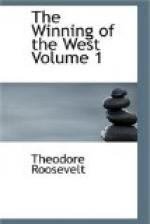By the end of July, Williamson had gathered over eleven hundred militia[54] (including two small rifle companies), and advanced against the Indian towns, sending his spies and scouts before him. On the last day of the month he made a rapid night march, with three hundred and fifty horsemen, to surprise Cameron, who lay with a party of tories and Indians, encamped at Oconoree Creek, beyond the Cherokee town of Eseneka, which commanded the ford of the river Keowee. The cabins and fenced gardens of the town lay on both sides of the river. Williamson had been told by his prisoners that the hither bank was deserted, and advanced heedlessly, without scouts or flankers. In consequence he fell into an ambush, for when he reached the first houses, hidden Indians suddenly fired on him from front and flank. Many horses, including that of the commander, were shot down, and the startled troops began a disorderly retreat, firing at random. Col. Hammond rallied about twenty of the coolest, and ordering them to reserve their fire, he charged the fence from behind which the heaviest hostile fire came. When up to it, they shot into the dark figures crouching behind it, and jumping over charged home. The Indians immediately fled, leaving one dead and three wounded in the hands of the whites. The action was over; but the by-no-means-reassured victors had lost five men mortally and thirteen severely wounded, and were still rather nervous. At daybreak Williamson destroyed the houses near by, and started to cross the ford. But his men, in true militia style, had become sulky and mutinous, and refused to cross, until Col. Hammond swore he would go alone, and plunged into the river, followed by three volunteers, whereupon the whole army crowded after. The revulsions in their feelings was instantaneous; once across they seemed to have left all fear as well as all prudence behind. On the hither side there had been no getting them to advance; on the farther there was no keeping them together, and they scattered everywhere. Luckily the Indians were too few to retaliate; and besides the Cherokees were not good marksmen, using so little powder in their guns that they made very ineffective weapons. After all the houses had been burned, and some six thousand bushels of corn, besides peas and beans, destroyed, Williamson returned to his camp. Next day he renewed his advance, and sent out detachments against all the other lower towns, utterly destroying every one by the middle of August, although not without one or two smart skirmishes.[55] His troops were very much elated, and only the lack of provisions prevented his marching against the middle towns. As it was, he retired to refit, leaving a garrison of six hundred men at Eseneka, which he christened Fort Rutledge. This ended the first stage of the retaliatory campaign, undertaken by the whites in revenge for the outbreak. The South Carolinians, assisted slightly by a small independent command of Georgians, who acted separately, had destroyed the lower Cherokee towns, at the same time that the Watauga people repulsed the attack of the Overhill warriors.




